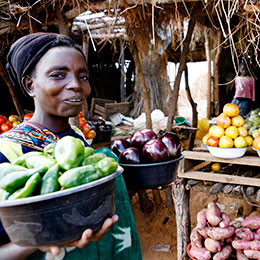FANTA and the Food and Agriculture Organization of the United Nations (FAO) hosted a technical meeting on July 15–16, 2014, to reach consensus on a global dietary diversity indicator to use as a proxy for assessing the micronutrient adequacy of women’s diets. The meeting built on research carried out by the Women’s Dietary Diversity Project (WDDP). FANTA led the first phase of the WDDP project (from 2005–2010) to develop and validate a simple indicator to reflect the micronutrient adequacy of women’s diets. The resulting publications from this research—including seven articles published as a Special Supplement in the Journal of Nutrition. A second phase of research (2012–present), led by FAO with support from the European Union, used more data and additional analyses, with an aim to identify and propose a dichotomous indicator for global use. New results from this research will be presented and discussed at the meeting.
Meeting participants included representatives from USAID; FANTA; FAO; the Agriculture-Nutrition Community of Practice; Biodiversity International; the Department for International Development; the Bill and Melinda Gates Foundation; Demographic and Health Surveys Program; Global Alliance for Improved Nutrition; the International Food Policy Research Institute; the International Fund for Agricultural Development; International Research for Development; Iowa State University; the Pan American Health Organization; the Strengthening Partnerships, Results, and Innovations in Nutrition Globally project; Tufts University; UNICEF; University of California, Davis; the World Food Programme; and the World Bank.
At the meeting participants unanimously endorsed the use of a new indicator called Minimum Dietary Diversity – Women (MDD-W). The new indicator reflects consumption of at least five of ten food groups; women consuming foods from five or more of the following food groups have a greater likelihood of meeting their micronutrient needs than women consuming foods from fewer food groups.

The indicator can be generated from surveys and provides a new tool for assessment, target-setting, and advocacy. The links below provide further information on the indicator and meeting accomplishments.
FAO Report: Moving Forward on Choosing a Standard Operational Indicator of Women’s Dietary Diversity
July 2014 Meeting Report and Presentations
- Meeting Summary Report
- Indicator Selection Reminders
- Methodology Overview: WDDP-I
- Methodology Overview: WDDP-II
- WDDP-II Results: Datasets Description and Performance of 2 Candidate Indicators
- Overview of Operational and Practical Considerations Related to a Women's Dietary Diversity Indicator for Global Assessment
- How the Selected Indicator of Women's Dietary Diversity can be Interpreted and Communicated
- Next Steps
- Summary



